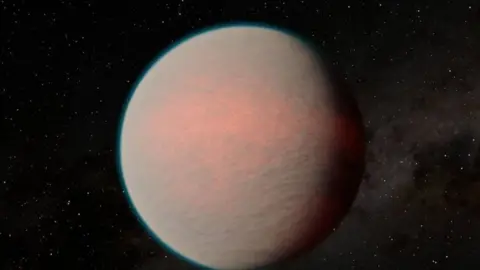Scientist makes alien weather forecast for distant planet
 NASA/JPL-Caltech/R. Hurt (IPAC)
NASA/JPL-Caltech/R. Hurt (IPAC)A scientist's "alien weather forecast" for a distant planet has helped a NASA-coordinated team gain a new understanding of it.
Dr Michael Roman, from the University of Leicester, made the observations about the atmospheric conditions on the planet GJ 1214b, which was discovered in 2009.
His work forms part of an international research programme led by NASA.
He said he hoped to carry out further work on the planet soon.
Dr Roman, from the University of Leicester School of Physics and Astronomy, said: "A decade ago, astronomers tried to determine GJ 1214b's atmospheric composition using the Hubble Space Telescope, but when they examined the data, they found that the planet was veiled in a thick layer of cloud or haze.
"This thick, blanketing haze layer prevented them from seeing the composition of the atmosphere.
"What we needed were observations that could peer through this layer."
'Mysterious'
Dr Roman used the Mid-Infrared Instrument (MIRI) on NASA's James Webb Space Telescope.
Leicester scientists were involved in the design, manufacture and testing of the telescope, which began full science operation in 2022.
Dr Roman said GJ 1214 b was bigger than Earth but smaller than Neptune.
He said planets like this were quite common across the galaxy and so scientists were eager to understand them better.
 Dr Michael Roman
Dr Michael Roman"The MIRI instrument was indeed able to see through some of this thick haze, revealing, for the first time, hints of GJ 1214b's atmospheric composition and temperature," said Dr Roman.
"We detected a feature that appears consistent with the presence of water vapour and possibly methane.
"We also found that this thick haze was quite reflective... causing the planet to be cooler than we expected."
The observations have fed into a paper published in the science journal Nature.
 University of Maryland
University of Maryland"The planet's atmosphere is totally blanketed by some sort of haze or cloud layer," said Eliza Kempton, a researcher at the University of Maryland and lead author of the paper.
"The atmosphere just remained totally hidden from us until this observation."
Dr Roman said he and his team were hoping to carry out more observations on the planet soon.
"The hope is that we can get even more precise measurements of the planet's atmosphere and better determine the composition of this mysterious, cloud-veiled world," he said.

Follow BBC East Midlands on Facebook, on Twitter, or on Instagram. Send your story ideas to [email protected].
